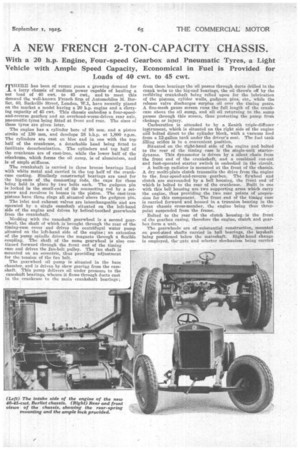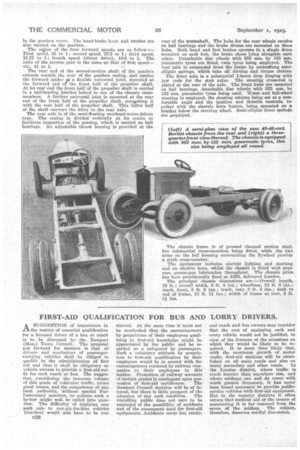A NEW FRENCH 2-TON-CAPACITY CHASSIS.
Page 9

Page 10

If you've noticed an error in this article please click here to report it so we can fix it.
With a 20 h.p. Engine, Four-speed Gearbox and Pneumatic Tyres, a Light Vehicle with Ample Speed Capacity, Economical in Fuel is Provided for Loads of 40 cwt. to 45 cwt.
THERE has been of recent years a growing demand for a lorry chassis of medium power capable of hauling a net load of 40 cwt. to 45 cwt, and to meet this demand the well-known French firm of Automobiles M. Berliet, 40, Sackville street, London, W.1, have recently placed on the market a model having .a 20 h.p. engine and a 'tarrying capacity of 45 cwt. This chassis embodies a four-speedand-reverse gearbox and an overhead-worm-driven rear axle, pneumatic-Ayres being fitted at front and rear. The sizes of these tyres are given later.
The engine has a cylinder bore of 90 rem. and a piston stroke of 130 mm, and develops 28 b.h.p. at 1,800 r.p.m. The cylinders are cast en bloc and in one with the top half of the crankcase, a detachable head being fitted to facilitate decarbonization. The cylinders and top half of the crankcase are of cast-iron, while the lower half of the crankcase, which forms the oil sump, is of aluminium, and is of ample stiffness.
The crankshaft is carried in three bronze bearings lined with white metal and carried in the top half 'of the crankcase casting. Similarly constructed bearings are used for the big-ends of the connecting rods, the caps for these being held in place by two bolts each. The gudgeon pin is locked in the small-end of gib connecting rod by a setscrew and revolves in bosses in the piston. The cast-iron pistons have three rings all situated above the gudgeon pin.
The inlet and exhaust valves are interchangeable and are operated by a single camshaft situated on the left-hand side of the engine and driven by helical-toothed gearwheels from the crankshaft.
Meshing with the camshaft gearwheel is a second gearwheel, the shaft of which is'brought through the rear of the timing-case cover and drives the centrifugal water pump situated on the left-hand side of the engine ; an extension of the pump spindle drives the magneto through a flexible coupling-. The shaft of the same gearwheel is also continued forward through the front end of the timing ease and drives the fan-belt pulley, The fan shaft is mounted on an eccentric, thus providing adjustment for the tension of the fan belt.
The gearwheel oil pump is situated in the base chamber. and is driven by skew gearing from the camshaft. This pump delivers oil under pressure to the camshaft bearings, whence it flows through duets cast in the crankcase to the main crankshaft bearings ; from these bearings the oil passes through ducts drilled in the crank webS to the big-end bearings, the oil thrown off by the refolving crankshaft being relied upon for the lubrication of the pistons, cylider walls, gudgeon pins, etc., while the release valve discharges surplus oil over the timing gears. A fine-mesh gauze screen runs the full length of the crankcase above the oil sump, and all oil returning to the sump passes through this screen, thus protecting the pump from chokage or injury.
Carburation is attended to by a Zenith triple-diffuser instrument, which is situated on the right side of the engine and bolted direct to the cylinder block, with a vacuum feed from a 12-gallon tank under the driver's scat. The fuel tank filling orifice iS in a convenient position.
Situated on the right-hand side of the engine and bolted to the rear of the timing case is the single-unit starterdynamo. This dynamotor is driven by a silent chain from the front end of the crankshaft, and a combined cut-out and foot-operated starter switch is embodied in the circuit.
A built-up radiator is mounted at the front of the chassis. A dry multi-plate clutch transmits the drive from the engine to the four-speed-and-reverse 'gearbox. The flywheel and clutch are surrounded by a bell housing, the front end of which is bolted to the rear of the crankcase. Built in one with this bell housing are two supporting arms which carry the engine, thus providing the two rear points of suspension for this component. The front -end of the timing case is carried forward and housed in a trunnion bearing in the fruit chassis cross-member, the engine being thus threepoint suspended from the frame.
Bolted to the year of the clutch housing is the front of the gearbox casing, therefore the engine, clutch and gearbox form a unit.
The gearwheels are of substantial construction, mounted on good-sized shafts carried in ball bearings, the layshaft being positioned below the mainshaft. Right-hand change is employed, the gate and selector Mechanism being carried in the gearbox cover. The band-brake lever and ratchet are also carried on the gearbox.
The ratios of the four forward apeeds are as follow:— First speed, 41 to 1; second speed, 27.5 to 1; third speed, 17.75 to 1; fourth speed (direct drive), 10.6 to 1. The ratio of the reverse gear is the same as that of first speed— viz., 41 to 1.
The rear end of the second-motion shaft of the gearbox extends outside the rear of the gearbox casing, and carries the forward spider of a flexible universal joint, Mounted at the forward end of the front half of the propeller shaft. At its rear end the front half of the propeller shaft is carried in a ball-bearing bracket bolted to one of the chassis crossmembers. A further universal joint is mounted at the rear end of the front half of the propeller shaft, convoting it with the rear half of the propeller shaft. This latter half of the shaft conveys the drive to the rear axle.
The rear axle is of the semi-floating overhead-worm-driven type. The casing is divided vertically at its centre to facilitate inspection of the gearing, which is carried on ball bearings. An adjustable thrust bearing is provided at the rear of the wormahaft. The hubs for the rear wheels revolve on bail bearings and the brake drums are mounted on these hubs. Both hand and foot brakes operate in a single drum mounted on each hub, the brake shoes lying alongside each other. Detachable disc wheels with 955 mm. by 155 mm. pneumatic tyres are fitted, twin tyres being employed. The rear axle is suspended from the frame by undenglung semielliptic springs, which take all driving and torque strains.
The front axle is a substantial I-beam drop forging with jaw ends for the stub axles. The steering cross-rod is placed at the rear of the axle. The front hubs are mounted on ball bearings, detachable disc wheels with 955 mm. by 155 mm. pneumatic tyres being used. Warm and full-wheel steering is employed, the steering column being set at a comfortable angle and the ignition and throttle controls, together with the electric horn button, being mounted on a bracket below the steering wheel. Semi-elliptic front springs are employed.




























